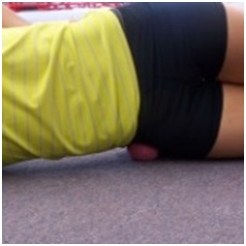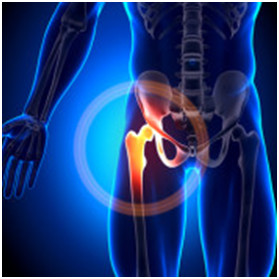Author: Julie Donnelly, LMT –The Pain Relief Expert
Editor: Dr. Steve Chaney
Do You Exercise Frequently?
Do You Have Aches & Pains?
Wish there was a natural treatment for hip pain? Exercising and playing sports is a “pluses and minuses” situation because it’s great to build muscle and burn fat, but it can also cause joint pain.
And athletes are especially vulnerable for hip pain.
Today I taught a serious triathlete an at-home hip pain treatment. Up until now he has been side-lined because of chronic hip pain. He’s an excellent runner and a top cyclist, but both of these sports have caused hip pain so extreme that he had to seek treatment.
The Cause of Hip Pain
The hip has powerful muscles attached to it so you can stand, sit, bend, maintain balance and move your body in an infinite number of ways. Each muscle needs to work perfectly with the other supporting muscles. As one contracts the opposing muscle needs to lengthen.
For example, sitting for extended periods of time is a key cause of pain all the way from your low back to your knees! In order for you to be able to sit various muscles contract including your psoas and iliacus muscles (front of pelvis), meanwhile your quadratus lumborum (low back) and rectus femoris (front of thigh) must lengthen.
As you stand those muscles switch roles – unless one or more of them have shortened because of a phenomenon called “muscle memory”. When this happens the tight muscle pulls on the bone causing tightness in the pelvis which leads low back pain, groin pain, sciatica or pain in the front of your hip.
Pain on the outside of your hip happens because these muscles are rotating your pelvis forward and down, and this rotation causes the muscles on the outside of your hip to torque. This torquing causes spasms (muscles knots or trigger points) to form in your hip muscles and the pull refers pain to your entire hip area.
If you play a sport that involves kicking your leg out to the side, such as soccer or ice skating, you are repetitively straining your hip muscles, specifically your tensor fascia lata, gluteus minimus and gluteus medius. These muscles apply tension on the outside of the pelvis and on the top of the thigh bone making your entire hip hurt!
A Natural Treatment for Hip Pain
 To release the muscles on the outside of your hip, take the Trigger Point Therapy Ball and place it directly on the side-seam of your pants, between your hip bone and your thigh bone. This is the location of your tensor fascia lata muscle, which is a key muscle when treating for hip pain.
To release the muscles on the outside of your hip, take the Trigger Point Therapy Ball and place it directly on the side-seam of your pants, between your hip bone and your thigh bone. This is the location of your tensor fascia lata muscle, which is a key muscle when treating for hip pain.
Lie down on the ball (as pictured). You may need to ease into it if your muscle is very tight. The goal is to be able to lie on the ball without feeling pain.
This could take a few minutes if your muscle is in spasm.
Once you are able to lie on the ball without pain, begin to move your body so the ball moves down to the insertion point (top of your thigh bone).
Then move so the ball rolls along your entire pelvis and sacrum.
As you move along feel for any tender spots. Each tender spot is a trigger point (muscle knot or spasm) that is causing your hip pain.
When you feel a trigger point allow your body to rest there for 30-60 seconds for a full muscle release.
Need More Help?
There are so many muscles involved in hip pain that I suggest you watch the Focused Flexibility Training Foundation video. The Foundation video is a comprehensive demonstration of muscle release techniques from head-to-toe.
After you release the knots in your muscles it is now the best time to stretch. In the Focused Flexibility Training system the two lower body sessions effectively stretch the muscles of your hip
Wishing you well,
Julie Donnelly
About The Author
 Julie Donnelly is a Deep Muscle Massage Therapist with 20 years of experience specializing in the treatment of chronic joint pain and sports injuries. She has worked extensively with elite athletes and patients who have been unsuccessful at finding relief through the more conventional therapies.
Julie Donnelly is a Deep Muscle Massage Therapist with 20 years of experience specializing in the treatment of chronic joint pain and sports injuries. She has worked extensively with elite athletes and patients who have been unsuccessful at finding relief through the more conventional therapies.
She has been widely published, both on – and off – line, in magazines, newsletters, and newspapers around the country. She is also often chosen to speak at national conventions, medical schools, and health facilities nationwide.
These statements have not been evaluated by the Food and Drug Administration. This information is not intended to diagnose, treat, cure or prevent any disease.

